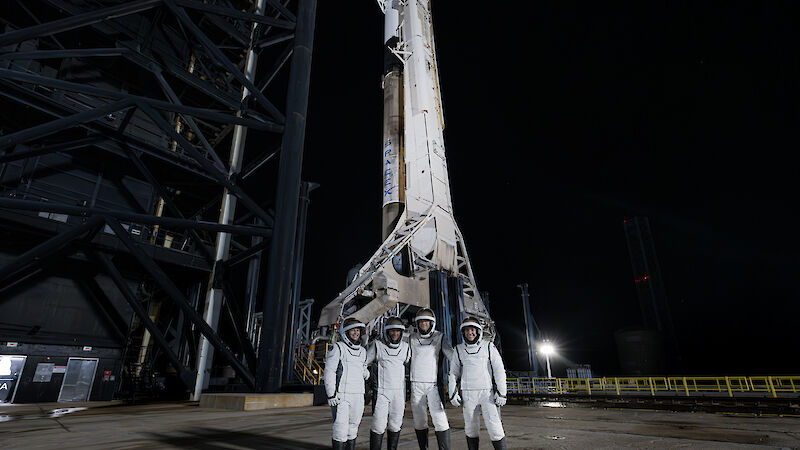Astronauts and Australian Antarctic expeditioners are working together to advance human health in space, and on Earth.
Today, four astronauts are orbiting Earth on the Polaris Dawn mission, undertaking a range of research projects to better understand the effects of long-duration spaceflight on human health.
At the same time, expeditioners and doctors at Australia's Antarctic and sub-Antarctic stations are collecting data for two of the projects, involving ultrasound and body scanning technology.
Australian Antarctic Division Chief Medical Officer, Dr Jeff Ayton, said the two projects were part of a collaboration with the US-based Translational Research Institute for Space Health (TRISH)*.
"Antarctic expeditioners and astronauts are both isolated, confined populations in extreme environments, doing hazardous work, dependant on technology for survival, and with limited scope for evacuation," he said.
"This makes Australia's Antarctic Program an excellent analogue for understanding the risks to humans in space, and for testing and developing technologies and methodologies to reduce these risks.
"Our collaborative work with TRISH will help inform how to monitor, diagnose and optimise astronaut health during long-duration space missions to the Moon and Mars.
"It will also inform healthcare technologies and practices used in other remote and regional environments here on Earth."

Useful ultrasound
Australian Antarctic Division Medical Practitioner, Dr John Cherry, said the first project involved developing and trialling protocols for non-specialists to use portable ultrasound technology to produce "clinically useful" images.
Expeditioners follow the step-by-step protocols to scan the internal structure of the eyes, jugular vein, heart, kidneys and bladder. Some also practice on a medical-grade gel containing fake blood vessels, called a 'phantom'.
The resulting scans are sent to US-based researchers for assessment.
"Our colleagues are assessing the quality of the images and whether a diagnosis could be made from them," Dr Cherry said.
"But we also look at whether the people who practice with the phantom produce better scans than those who don't.
"This will allow us to determine whether astronauts need to train on a phantom during their flight, to maintain their competence for the real thing."
Dr Ayton said that in space, the images could be reviewed by a practiced flight surgeon on the spacecraft, or sent back to Earth for review by a specialist.
In remote communities on Earth, the images can be reviewed by specialists in larger cities.
"This technology has come such a long way in recent years that it's enabling bedside, or 'point of care', testing," Dr Ayton said.
"It doesn't replace formal ultrasonography, but it can be used to assist decision making to improve outcomes for patients in isolated or extreme environments."
Body double
The second project being undertaken simultaneously in space and Antarctica, uses a 3D optical (3DO) body scanner to look at changes in body shape and composition (fat, muscle and potentially bone) and its impact on metabolic health.
Most people experience muscle loss and metabolic health changes when their ability to exercise is restricted, often after injury or illness.
In Antarctica, expeditioners can experience fluctuations in weight between winter and summer, and changes in muscle mass, depending on their exercise regime, which can affect their metabolic health.
Astronauts rapidly experience muscle and bone mass loss in microgravity, which increases the risk of osteoporosis and subsequent fractures. They also experience a redistribution of fluid from other parts of the body to the face.
"Astronauts do several hours of exercise every day to maintain their strength and conditioning, but after a six-month mission to the International Space Station, they still need to be supported to walk again when they return to Earth because they've lost the muscle bulk in their legs," Dr Cherry said.
"As we look towards missions to Mars, astronauts will need to be able to get up and walk by themselves when they land."
The 3DO body scanner project will help doctors and researchers understand how to support astronauts and Antarctic expeditioners to be as healthy as they can during their deployments.
"We're using an app that turns the facial recognition cameras on a smart phone into a laser scanner," Dr Cherry said.
"In Antarctica, participants stand with their arms and legs apart, and as the station doctor walks around them with the phone, the scanner creates a 3D avatar of them.
"It takes about 40 seconds and we do the scans every two months to monitor changes in body shape and composition. We also take physical measurements, such as grip strength, and ask expeditioners to keep diet diaries and answer activity questionnaires."
The team recently published the positive results of a 3DO evaluation involving expeditioners at Davis and Mawson, which is now being extended to include Casey and Macquarie Island.
"This is a really exciting area of research because no one has looked at these sort of metabolic changes in such a way, for deployed teams in extreme environments," Dr Ayton said.
"The use of these portable, easy-to-use and publicly available technologies is helping revolutionise healthcare in remote and extreme environments and design strategies to address the unique challenges each presents."
Propelling healthcare from the frozen reaches at the bottom of the Earth, to the Moon, Mars and beyond.
*The Translational Research Institute for Space Health (TRISH) is a United States-based institute led by Baylor College of Medicine's Center for Space Medicine, in partnership with the California Institute of Technology and Massachusetts Institute of Technology. TRISH is empowered by NASA's Human Research Program and is funded through a cooperative agreement.






